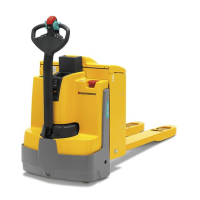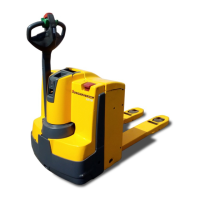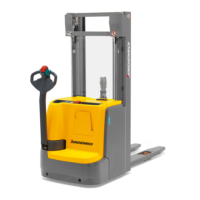Do you have a question about the Jungheinrich EJE 222 and is the answer not in the manual?
Details important safety symbols and their meanings for safe operation.
States the copyright ownership of the operating instructions.
Defines user roles and ensures safe operation within design limits.
Specifies requirements for mounting approved attachments to the truck.
Outlines the intended use and lists different truck models with their capacities and motor outputs.
Identifies and labels the main components and assemblies of the truck.
Provides detailed technical specifications, including performance data, dimensions, and EN standards.
Locates and explains the purpose of various labels and identification plates on the truck.
Details the correct method for lifting and transporting the truck using a crane.
Outlines the necessary operations before the truck can be put into service.
Explains how to release the brake to move a truck in an emergency.
Covers safety regulations for handling lead-acid batteries, including personal protection and fire prevention.
Lists standard battery combinations and capacities based on chassis versions.
Describes the procedure to safely access the battery compartment.
Details the steps and safety precautions for charging the truck's battery.
Provides instructions for safely removing and installing the battery, including handling and securing.
Explains the combined instrument's display for battery charge and operating hours.
Outlines essential safety regulations for operating forklift trucks, including driver authorization and hazardous areas.
Identifies and describes the truck's controls, indicators, and their functions.
Details pre-operation checks and the procedure for starting up the truck.
Covers safe driving conduct, visibility, negotiating slopes, and load handling practices.
Explains how to drive, steer, brake, and use emergency stop functions.
Describes the procedures for safely lifting and lowering loads with the forks.
Specifies the correct procedure for parking and securing the truck when unattended.
Explains the code lock feature for commissioning and securing the truck.
Details how to select and customize travel programs for different operating conditions.
Guides on entering master codes and adjusting truck parameters for optimal performance.
Describes how to set and verify travel parameters like acceleration and speed.
Explains the battery discharge indicator, warning lights, and charge level displays.
Details how the discharge monitor cuts off lifting at low battery levels.
Describes the display of operating hours and how error codes are indicated.
Provides guidance on identifying and rectifying common truck malfunctions.
Covers general safety measures and environmental protection during maintenance.
Outlines safety precautions for personnel performing maintenance and repairs.
Defines service intervals (W, A, B, C) and recommendations for application-specific adjustments.
Lists specific checks and tasks for chassis, drive unit, wheels, steering, brakes, and hydraulics.
Covers checks for electrical system, motors, battery connections, and terminals.
Provides a lubrication chart and details required operating materials and greases.
Explains how to prepare the truck for servicing, including safety measures and opening hoods.
Details the procedure for checking and replacing electric fuses, with a table of fuse assignments.
Describes procedures for recommissioning after maintenance and decommissioning for storage.
Outlines requirements for annual safety checks and accident prevention inspections.
Covers correct procedures for final decommissioning and disposal of the truck.
Provides operating instructions, rating data, and safety for EPzS/EPzB traction batteries.
Details commissioning, discharging, and charging procedures for traction batteries.
Covers operating temperature limits and electrolyte specifications for traction batteries.
Outlines daily, weekly, monthly, and annual maintenance tasks for traction batteries.
Provides guidelines for storing batteries and procedures for handling malfunctions.
Explains the information found on the Jungheinrich traction battery type plate.
Describes the design and intended application of the Aquamatic/BFS water refilling system for batteries.
Explains the operational principles of the water refilling system.
Details manual/automatic filling, connection pressure, and required water quality.
Provides rating data and essential safety precautions for maintenance-free EPzV/EPzV-BS batteries.
Covers commissioning, discharging, and charging procedures for EPzV batteries.
Details temperature limits and electrolyte properties for maintenance-free batteries.
Outlines maintenance tasks, storage, and malfunction handling for EPzV batteries.
| Brand | Jungheinrich |
|---|---|
| Model | EJE 222 |
| Category | Forklifts |
| Language | English |











